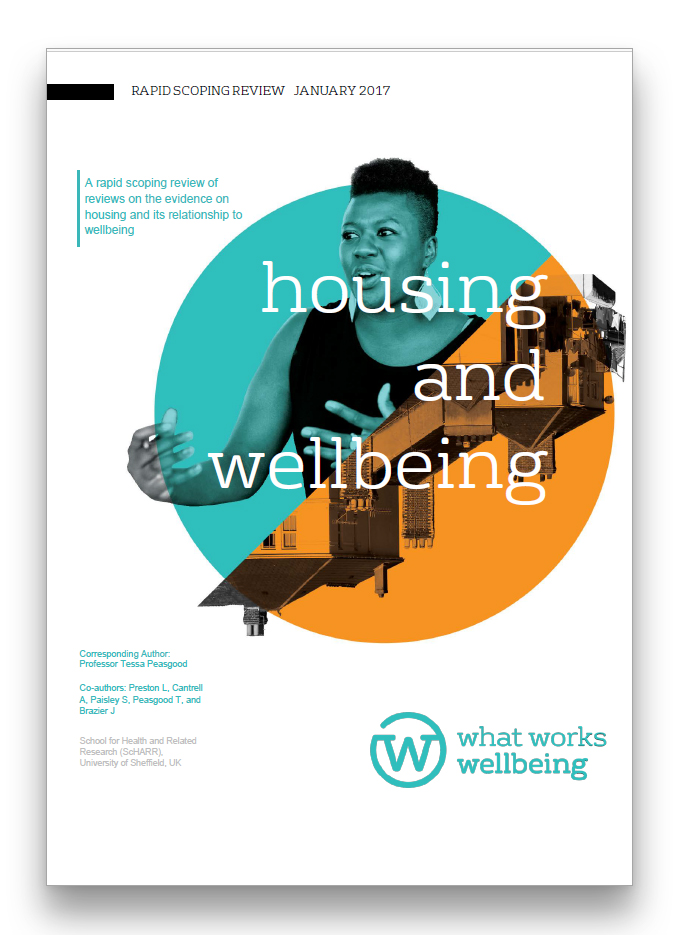To kick off 2017 we are publishing our scoping review on housing and wellbeing. It looks at what we know and where the gaps are. It also sets out what our focus will be for our upcoming systematic review on housing later this year. We’re focusing on housing and wellbeing because that’s what emerged as a priority area for a range of stakeholders in our public dialogues.

Read the full scoping review or the four-page briefing.
What does the English Housing Survey tell us about housing and wellbeing?
This week the What Works Centre for Wellbeing shares a new scoping review on housing and wellbeing. To mark this focus on communities and the built environment, we’re sharing a blog from the English Housing Survey Team in Department for Communities and Local Government.
Earlier in 2016, the Department for Communities and Local Government (DCLG) in collaboration with ZK Analytics and NatCen, published a report on housing and well-being. The report analyses life satisfaction and anxiety as measured by the ONS personal well-being questions. It also uses the English Housing Survey (EHS) to identify the personal characteristics and housing factors associated with wellbeing. Using a series of linear regressions, the report assesses the strength of housing factors in relation to that of personal characteristics.
Because the EHS includes both an interview with the members of the household and a physical inspection of the property, the analysis could examine the impact that housing conditions (e.g. tenure, type, dwelling condition, state of disrepair) as well as personal characteristics have on an individual’s wellbeing. This is the first time that such analysis has been conducted.
Main findings include:
- Life satisfaction and anxiety are primarily driven by personal characteristics such as health, marital and employment status. For example someone who considered their health to be very good had a level of life satisfaction 2.7 points higher than someone who considered their health to be very bad (on a scale ranging from 0 to 10). Some housing circumstances do however have significant effects.
- The top housing factor associated with both life satisfaction and anxiety was being in arrears with rent or mortgage payments. Being in arrears reduced an individual’s life satisfaction by 0.6 points and increased anxiety by 0.6 points (on a scale ranging from 0 to 10). These effects were similar in size to some personal factors, such as income after housing costs. This was associated with a difference of 0.6 points in life satisfaction between the lowest and highest income quintiles.
- Life satisfaction appeared to be influenced by other housing factors, however anxiety did not.
- For life satisfaction, the second most important property-related predictor was the type of tenure, with social renters having higher levels of life satisfaction (0.2 points higher than outright owners), if all other factors and characteristics were held constant.
- The next most important property-related predictor of life satisfaction was the type of dwelling. Compared to living in terraced houses, living in flats or semi-detached houses decreased life satisfaction. The largest difference observed was between people living in terraced houses and high rise purpose built flats; their level of life satisfaction was, on average, 0.3 points lower.
- The final significant property-related predictor of life satisfaction was repair costs. As the average cost of repairs per square metre increased from £0 to £41 (the mean), the level of satisfaction decreased by 0.03 points.
- Overcrowding (as measured by the bedroom standard) and other housing factors did not appear to have a significant effect on life satisfaction.
The research raises several interesting questions, and has helped us identity a number of areas which would benefit from further exploration.
For example, we are considering adding questions to the survey that assess housing conditions by measuring respondents’ subjective assessments. Respondents could be asked to state, for instance, whether they think their household is overcrowded (as opposed to using an objective indicator such as the Bedroom Standard). In addition, other factors relating to housing and the built environment such as age of dwelling, presence of outdoor space and dwelling density could be explored. The drivers of satisfaction with accommodation and what is the relationship between satisfaction with accommodation and well-being could also be analysed.
More detail, including links to the other reports recently published by DCLG can be found here. English housing survey datasets are also available for analysis. Please contact ehs@communities.gsi.gov.uk for any further queries.
